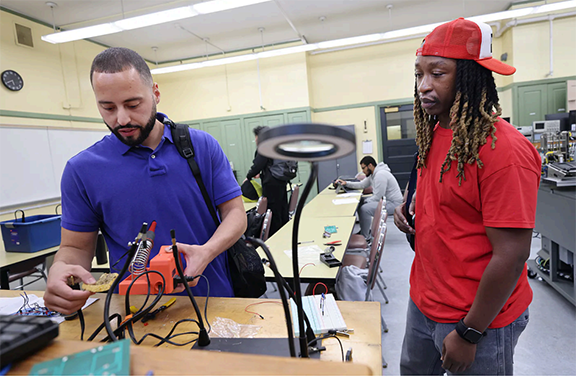November 14
EDITORIAL - The Boston Globe
Extend Pell grants to short-term workforce training
Certificate classes can help students enter a field, but right now they aren’t eligible for Pell grants.
By The Editorial Board Updated November 14, 2024

At Benjamin Franklin Cummings Institute of Technology in Boston, Osvaldo Medina, 37, left, and Alexander Harris, 42, worked in a Digital Principals lab class on Oct. 30. SUZANNE KREITER/GLOBE STAFF
Benjamin Franklin Cummings Institute of Technology, a private two-year college in Boston, offers an 800-hour certificate program in HVAC and refrigeration. President and CEO Aisha Francis said she’d like to break out segments of the program to create continuing education classes for HVAC technicians seeking to improve their skills — for example, offering a class in heat pump installation. But the school, which attracts primarily Black and Latino men interested in the trades, can’t make it work financially. About half the school’s students receive federal Pell grants to help finance their education, and short-term certificate classes are ineligible for Pell funding.
“Most of our students are very low income, so even though they want the skill set, they’re not able to pay for them,” Francis said.
Many fields today are facing workforce shortages. At the same time, there are students seeking a quick credential to enter the job market. Short-term certificate programs can help students get an entry-level job or gain new skills. For example, a student interested in medicine can train as a certified nursing assistant or emergency medical technician, then earn money while deciding whether they want to continue climbing the health care career ladder.
Yet federal Pell grants — the major source of financial aid for low-income students — aren’t awarded for programs that are shorter than 600 hours or less than 15 weeks. That leaves low-income students, who are often those seeking certificates, scrambling to pay out of pocket and schools searching for alternative funding. Schools may offer fewer courses because interested students can’t afford to pay.
Congress has been considering bipartisan bills to expand Pell eligibility for short-term classes. Passing legislation would be a win for Republicans advocating for more workforce-related education and for Democrats seeking to expand educational access for low-income students. More importantly, it would help students gain marketable skills and employers fill open jobs.
While legitimate concerns have been raised about ensuring that Pell-eligible credential programs are high-quality, legislation could address those concerns by establishing objective standards programs must meet. For example, programs that train students for a licensing exam could only retain eligibility if a certain percentage of graduates pass the exam within a reasonable time frame after graduation. Other metrics could involve job placement rates, program completion rates, or enhanced earnings.
“It’s increasingly clear that most jobs require some degree of postsecondary training, and it’s been hard to develop viable alternative pathways to college for students who are not enrolling in four-year degree programs without financial support,” said Martin West, academic dean at the Harvard Graduate School of Education. Expanding Pell, West said, “could create innovation in that space.”
Francis said Franklin Cummings Tech would offer more classes in construction-related fields like land surveying or blueprint reading if they were Pell eligible. And she expects that some people who earn short-term certificates would advance to other degrees. “We know these kinds of measures actually push more people into higher education,” Francis said. “It’s just a matter of will. Do we want to help more people get better educated or not?”
The biggest proponents of expanding Pell have been community colleges. At North Shore Community College, around 500 students are enrolled in short-term professional programs in areas like health care and information technology. Jennifer James Price, assistant vice president of employer relations for the college, said she works with local hospitals, community health centers, and nursing homes, which are desperate for nursing assistants, phlebotomists, and other program graduates. To pay for these programs, the school has been chasing grants, but those aren’t reliable, and tuition for a health care certification can cost up to $3,000. (The state’s free community college program also doesn’t apply to certificate classes.) “It doesn’t build a steady expectation for students or businesses in the North Shore where [classes are] happening at a low cost all the time,” Price said.
There is evidence that paying for workforce training works. In fiscal 2023 and 2024, Massachusetts created a $15 million state fund to pay for workforce training in high-need fields at community colleges. According to a report by the Massachusetts Association of Community Colleges, 3,359 students completed these programs, the majority of them in health care, and 2,404 of those graduates (66 percent) found a job or were enrolled in continuing education within 90 days of program completion.
Bills introduced in Congress would authorize Pell grants for students enrolled in programs with at least 150 hours, with guardrails to ensure the programs are high-quality and fulfill employer needs. There has been some dispute over whether to include for-profit colleges, which have historically charged students more money than nonprofits with worse outcomes. Guardrails that restrict eligibility to programs that meet objective criteria — like the ability to pass a licensing exam or get a job — would address concerns about quality, regardless of tax status.
There would be an estimated $1.7 billion cost to US taxpayers over 10 years, according to the Congressional Budget Office. As the House considered advancing the bill earlier this year, Republicans inserted a poison pill, proposing to pay for the expansion by restricting federal loans to students at schools with large endowments. Give the size of the federal budget, experts say there are undoubtedly other, less controversial sources of money that can be tapped to pay to expand Pell, which is already an approximately $25 billion-a-year program.
Expanding Pell eligibility to short-term certificate programs would help students, schools, and employers. Congress should resist the temptation to play politics and pass the policy.

